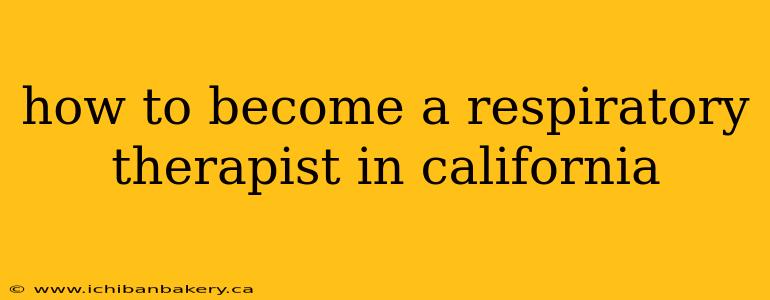Meta Description: Aspiring to become a Respiratory Therapist in California? This comprehensive guide outlines the educational requirements, licensing process, and career outlook for R.T.s in California. Learn about the necessary steps, including accredited programs, the CRT and RRT exams, and how to apply for licensure. Discover the rewarding career path awaiting you in this in-demand healthcare profession!
A Rewarding Career Path: Respiratory Therapy in California
Respiratory therapists (RTs) play a vital role in healthcare, providing life-supporting treatments and managing respiratory conditions. If you're passionate about helping others and interested in a challenging yet rewarding career, becoming a respiratory therapist in California could be the perfect path for you. This guide will walk you through the necessary steps to achieve your goal.
Educational Requirements: The Foundation of Your Career
The first step to becoming a respiratory therapist in California is completing an accredited educational program. California requires you to graduate from a Commission on Accreditation for Respiratory Care (CoARC)-accredited program. These programs typically offer either an associate's or bachelor's degree.
Choosing the Right Program
Researching and selecting the right program is crucial. Consider factors like:
- Program Accreditation: Ensure CoARC accreditation.
- Program Location: Choose a location convenient for you.
- Clinical Experience: Look for programs offering ample hands-on experience.
- Faculty Expertise: Research the instructors' backgrounds and experience.
- Job Placement Assistance: Many programs offer assistance finding jobs after graduation.
Curriculum Overview: What to Expect
Expect a rigorous curriculum covering topics such as:
- Respiratory Care Principles: Understanding the mechanics of breathing and gas exchange.
- Cardiopulmonary Anatomy and Physiology: In-depth knowledge of the heart and lungs.
- Diagnostic Procedures: Performing and interpreting various tests.
- Therapeutic Interventions: Administering medications and treatments.
- Patient Assessment and Care: Developing critical thinking skills for patient care.
Licensing and Certification: The Next Steps
Once you've completed your education, you'll need to obtain the necessary licenses and certifications to practice in California.
Passing the Certification Exams
You'll need to pass two crucial exams administered by the National Board for Respiratory Care (NBRC):
- Certified Respiratory Therapist (CRT) Exam: This exam tests your knowledge and skills learned in your associate's degree program.
- Registered Respiratory Therapist (RRT) Exam: This exam is for those with a bachelor's degree and assesses advanced knowledge and skills. Many employers prefer RRTs.
Applying for a California License
After passing the relevant NBRC exam, you'll need to apply for a California license through the Respiratory Care Board of California. This involves submitting your transcripts, exam results, and other required documentation. The process typically involves background checks.
Maintaining Your License: Continuing Education
Continuing education is essential to maintain your California respiratory therapist license. The Respiratory Care Board of California specifies the required continuing education units (CEUs) you need to complete periodically. Staying current with advancements in the field is crucial for providing optimal patient care.
Career Outlook and Salary Expectations for Respiratory Therapists in California
California has a strong demand for respiratory therapists. The field offers excellent career opportunities with competitive salaries and benefits. Job prospects are expected to remain strong for the foreseeable future. Salaries vary depending on experience, location, and employer. Consult resources like the California Employment Development Department (EDD) for current salary data.
Frequently Asked Questions (FAQ)
How long does it take to become a respiratory therapist in California?
The time commitment depends on your chosen educational path. Associate's degree programs typically take two years, while bachelor's degree programs take four years. Add time for exams and licensing.
What are the job duties of a respiratory therapist?
RTs perform a wide range of duties, including:
- Assessing respiratory function: Using various diagnostic tools.
- Administering respiratory treatments: Such as oxygen therapy, medications, and mechanical ventilation.
- Educating patients and families: About respiratory conditions and management.
- Monitoring vital signs: Tracking patient progress.
- Collaborating with other healthcare professionals: As part of a multidisciplinary team.
What is the difference between a CRT and an RRT?
A CRT (Certified Respiratory Therapist) holds an associate's degree and has passed the CRT exam. An RRT (Registered Respiratory Therapist) holds a bachelor's degree and has passed both the CRT and RRT exams. RRTs generally have more advanced skills and knowledge.
Conclusion: Embark on Your Respiratory Therapy Journey
Becoming a respiratory therapist in California is a challenging but rewarding endeavor. By following this guide and dedicating yourself to your education and professional development, you can launch a fulfilling career helping others breathe easier. Remember to consult the official websites of the NBRC and the Respiratory Care Board of California for the most up-to-date information and requirements.
